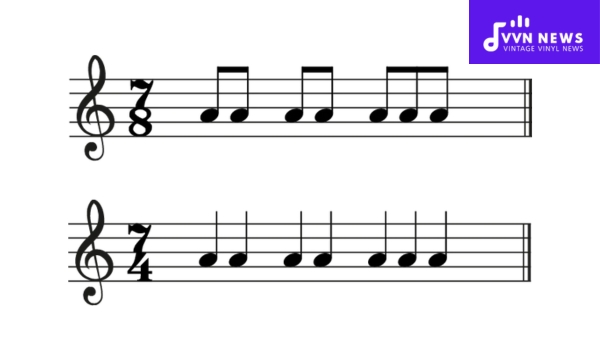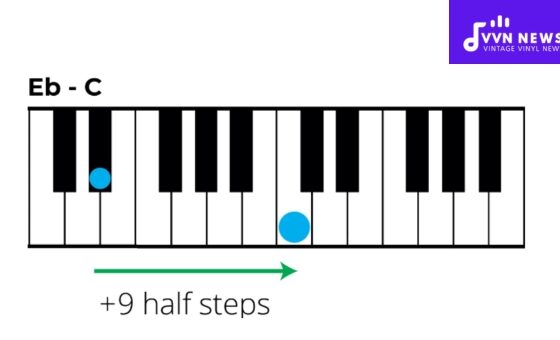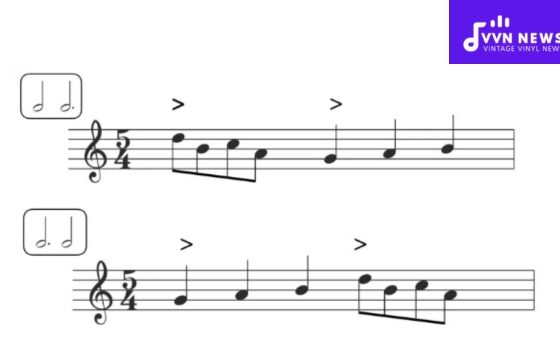Tackling the intricacies of music theory can be quite an adventure, and one of the more fascinating aspects that captivate musicians and listeners alike is the time signature.
Among these, time signature 7/8 holds a special place, often stirring curiosity for its unconventional rhythmic flavor.
If you’ve ever tapped your foot to a piece of music and found yourself tripping over an unexpected beat, you might have stumbled upon the intriguing world of 7/8.
The use of time signature 7/8 in compositions adds a layer of complexity that can transform an ordinary melody into a thrilling rhythmic journey.
Mastering how this asymmetrical pattern weaves its magic is essential for both performing musicians and those who simply appreciate the depth it brings to the music.
What Is Time Signature 7/8?
Time signature 7/8, also denoted as seven-eight time, is a rhythmic pattern where each bar contains seven beats divided into a combination of shorter pulses.
Picture a standard measure that you might divide into quarters or eighths. In 7/8, you’re counting seven of these eighth notes before you loop back to the start of the next bar.
An exciting aspect of this time signature lies in its subdivision potential; composers can split those seven beats into varied groupings such as 2-2-3, 3-2-2, or even a more complex structure like 2-3-2 to create different rhythmic feels.
This flexibility makes 7/8 a thrilling playground for rhythmic experimentation and can instill a piece with a compelling sense of movement and flow.
Also Read: A Sharp Minor Pentatonic Scale [Unique Harmonic Possibilities]
How Do You Count in 7/8 Time?
Counting in 7/8 time can initially feel like rhythmic gymnastics for your brain, but with some practice, it becomes second nature.
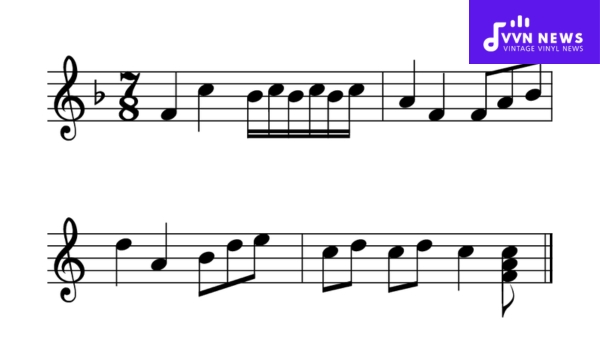
Imagine each ‘beat’ as a part of a short dance routine where the steps are not uniform. In essence, 7/8 is divided into smaller groupings of 2s and 3s.
Step-by-Step Guide:
- Begin with the Basics: First, recognize that 7/8 is comprised of seven quavers (eighth notes), making it an asymmetric meter. Since there are seven beats to a measure, you won’t fall into an even rhythm as you would in 4/4 time.
- Break Down the Beats: Typically, musicians break these seven beats into two counts of 2 and one count of 3 ([2+2+3]) or one count of 3 followed by two counts of 2 ([3+2+2]). This affects how we groove to the music.
- The Counting Formula: Using [2+2+3] as an example: You’d count “1-2, 1-2, 1-2-3”. Alternatively, using [3+2+2]: It’s “1-2-3, 1-2, 1-2”. Each number corresponds to an eighth note where “1” is emphasized slightly more than “2” or “3”—think of it as a gentle nudge on the first step in each grouping.
- Practice with a Metronome: Use a metronome set to eighth notes and accentuate the first beat in each group to maintain your pace and build muscle memory.
Proficiency requires patience and repetition – let rhythm become your guide as you waltz through the unique pulse of 7/8.
Why Is 7/8 Considered a Complex Time Signature?
At its core, the 7/8 time signature stands out as complex due to its asymmetric grouping of beats.
Traditional time signatures like 4/4 or 3/4 have an even division of beats that align with our natural inclination to group rhythms into equal sets—making them intuitive and straightforward.
7/8 disrupts this pattern. It consists of seven quavers (eighth notes) per measure, which are typically divided into uneven subgroups—such as 2+2+3 or 3+2+2—creating a syncopated and off-balance musical flow.
This unpredictable rhythm challenges both musicians and listeners; the former must master unusual accent patterns while maintaining tempo, and the latter often find themselves caught in a captivating rhythmic puzzle.
The incorporation of 7/8 may compel you to reevaluate how rhythm shapes your emotional response to music.
As composers weave these atypical time signatures into their work, they invite us into an audaciously unorthodox auditory experience.
What Are Some Songs That Use a 7/8 Time Signature?
Time signatures like 7/8 often bring a sense of excitement and unpredictability to a piece of music, drawing listeners into its rhythmical intricacy.
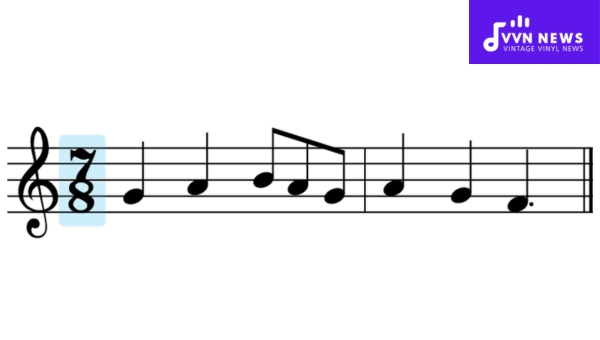
Let’s explore songs across various genres that exemplify the captivating use of 7/8.
Progressive Rock and the Lure of Odd Time
Progressive rock is notorious for its liberal experimentation with time signatures.
“Money” by Pink Floyd is a quintessential example, where the bass riff grooves through bars of 7/8, creating an unforgettable rhythmic hook.
The unmistakable sound of coins clinking introduces a sonic texture that accentuates the meter’s oddness.
Another progressive gem is “The Cinema Show” by Genesis. This track presents a more subtle use of 7/8, tucked within an extended instrumental piece, showcasing the band’s mastery over shifting meters without disrupting the flow.
Beyond Rock: Embracing World Music
World music often incorporates odd-time signatures. “Kaval Sviri,” a traditional Bulgarian folk song, rides on an undercurrent of 7/8 that courses through its harmonies and spirited melodies, all while remaining remarkably danceable.
Similarly, “Homecoming (Sanagi)” by Tigran Hamasyan magnificently blends jazz with Armenian folk themes in 7/8. His piano navigates through this complex meter with both grace and fervor.
Soundtracks With an Edge
Soundtracks aren’t left out when it comes to exploiting the intensity of uneven rhythms.
The theme for “Mission: Impossible,” originally composed by Lalo Schifrin, thrives on the tension built partly by its persistent 7/8 groove, which has become synonymous with espionage thrillers.
Delving Into Contemporary Pop and Rock
Even in mainstream pop and rock music, artists have dabbled in odd meters.
Sufjan Stevens‘ “The Tallest Man, The Broadest Shoulders” applies the pattern within an indie-folk context where it underscores lyrical ebb and flow.
Dave Brubeck Quartet’s jazz classic “Unsquare Dance,” although primarily in 7/4, dips into sections that feel like successive bars of 7/8 due to its phrasing—an honorable mention for illustrating adjacent territories in unconventional rhythms.
Embracing songs in time signature 7/8 broadens our rhythmic horizons as listeners and creators alike.
Embedded in rock riffs or woven into folk dances—this uneven meter never fails to intrigue ears accustomed to simpler beats. It demonstrates how artists across different genres defy expectations to deliver compelling auditory experiences.
Also Read: Transposition Chart [A Lifesaver For All Musicians]
How Can Ear Training Help Identify 7/8 Meters?
When delving into the world of odd time signatures, developing an astute ear becomes an indispensable asset.
Ear training for the identification of 7/8 meters involves cultivating a sense of both rhythm and melody.
Here’s how mastering auditory skills can bolster your ability to discern this unique time signature.
Recognizing Rhythmic Patterns
Listen actively and repeatedly to pieces written in 7/8 time. Focus on internalizing the unconventional pulse.
A common subdivision is to group the beats into sets of 2s and 3s, such as 2-2-3 or 3-2-2, which you might audibly count as “one-two one-two one-two-three.”
Learning to recognize these groupings is pivotal, as they form the foundation of what sets 7/8 apart from symmetrical meters.
Feel The Pulse
Exposing yourself to various genres that employ 7/8 allows your mind-body coordination to naturally attune to the meter’s ebb and flow.
It’s progressive rock, classical motifs, or world music rhythms, each genre offers its unique feel of 7/8 that can enrich your aural palette.
Clapping along or tapping your foot are excellent methods for physicalizing this odd-time signature.
Melodic Contours in 7/8
Melodies often accentuate the distinctive beat divisions within a bar of 7/8.
Pay attention not just to rhythm but how melodic phrases complete or suspend over the bar line.
This nuance signals if you’re dealing with conventional meters or something more asymmetric like 7/8.
Tools for Training
Utilize metronomes with odd-time capabilities that can articulate distinct beats within a measure—a valuable tool for isolating each component beat of the measure.
There are apps and online resources explicitly designed for ear training across varied time signatures (Teoria being a notable example).
By nurturing these skills through habitual practice and diverse auditory exposure, detecting a piece in 7/8 becomes not just an intellectual exercise but an intuitive realization—a telltale rhythmic narrative that stands out amidst the sea of more common musical structures.
Also Read: How To Transpose Bass Clef To Treble Clef [A How-To Guide]
What’s the Difference Between 7/8 and 7/4 Time Signatures?
Diving into the world of mixed meters, you’ll often come across both 7/8 and 7/4 times.
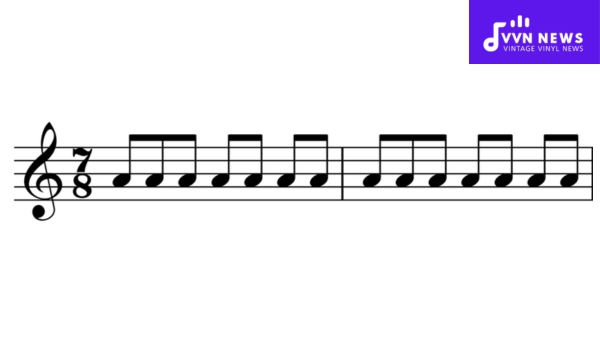
These two signatures might look similar at a glance, but their rhythmic pulse sets them apart.
Beat Division
In 7/8 time, beats are typically divided into groupings of 2s and 3s. For instance, you might encounter a pattern that goes 2+2+3, with an emphasis on the first beat of each grouping.
This division results in a feeling of urgency or a “limping” sensation due to the uneven distribution.
Pulse Consistency
Conversely, 7/4 time has a more consistent pulse as it is generally spaced out into seven-quarter notes.
This creates a steadier groove that feels less rushed compared to its counterpart.
Emphasis on Beat Groupings
Another point to consider is emphasis; in 7/8, there’s often an accent on the first beat after each division (i.e., beats 1, 3, and 5), while 7/4 tends to have more evenly spread-out accents due to its symmetrical nature.
By grasping these nuances, you will be better equipped to navigate through compositions with these intriguing meters and appreciate the rich tapestry they weave within the music.
Also Read: How To Transpose Treble To Bass Clef [Music Guide]
FAQs
What makes a 7/8 time signature unique?
7/8 is unique because it divides the measure into uneven beats, often giving the music a feeling of being off-balance or driving forward.
How do musicians typically count in 7/8 time?
Musicians might count 7/8 time as “1-2, 1-2, 1-2-3” or “1-2-3, 1-2, 1-2,” breaking the seven quavers (eighth notes) into groupings that add up to seven.
Can you dance to music in 7/8 time signature?
Yes, dancing to 7/8 time is possible and often seen in folk dances; it can be more challenging due to the irregular beat patterns.
Is learning to play in 7/8 time signature difficult?
Learning to play in 7/8 can be challenging at first due to its unusual phrasing but it becomes easier with practice and exposure.
Does sheet music indicate how to divide the beats in a bar of 7/8?
Sheet music doesn’t always specify how to divide beats in 7/8; this typically comes down to compositional context or performer interpretation.
Also Read: Why Should We Practice Scale? A Complete Guide
Conclusion
In wrapping up our exploration of the 7/8 time signature, I hope you feel more equipped to identify this distinctive meter in music.
It’s a rhythmic pattern that can enhance the dynamic nature of any composition, making it a favorite among composers seeking to add an unconventional twist to their work.
Keep an ear out for those seven-beat patterns; you’ll soon find them more familiar and less daunting.
This signature’s complexity is worth embracing, if you’re clapping along or crafting your melodies in 7/8. Embrace its uniqueness and let the beats expand your musical horizons.
